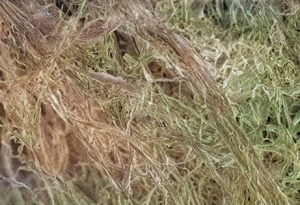Textile, clothing, toys, sports equipment and other products made from synthetic petroleum-based materials have a significant negative impact on the environment through their entire life cycle, from production to waste management. It is important to replace petroleum-based materials with environmentally friendly materials and to re-use them wherever possible.
Increased use of cellulose-based polymers – derived from the primary plant scaffold and therefore a natural building block – could address many issues associated with petroleum-based polymers. Cellulose is the Earth’s most abundant and widespread natural polysaccharide, commonly found in plant cell walls, algae or synthesised by certain bacteria.
Now, scientists at the Faculty of Chemical Technology (CTF) at the Kaunas University of Technology (KTU) in Lithuania. have developed a production method for a nanofibrous cellulose matrix, which has the potential to replace non-renewable alternatives, even in biomedical applications.
Discover Material Selection with Prospector Premium, learn more here!
According to PhD student Ingrida Pauliukaitytė, one of the creators of the new environmentally friendly cellulose nanofibre, products that have been in use for many years can be replaced while retaining their effectiveness. “I chose cellulose because of its natural origin and favourable properties – its biocompatibility and degradability, variety of chemical strains, and potential in wide range of applications,” said Pauliukaitytė.

The process uses wet-type electrospinning, whereby cellulose is dissolved in special solvents – environmentally friendly ionic liquids – and the solution is then converted into fibres. “This is a method that allows the creation of cellulose matrices with a unique gel-like structure, similar to the cellulose fibres naturally synthesised by bacteria,” Pauliukaitytė added.
Importantly, the raw material for this production process can be either raw cellulose or cellulose waste. Depending on the purity of the material, the resulting fibre can be used for different products, including toys, sports equipment and household items. While if the raw material is pure plant cellulose, biomedical applications have great potential, where this type of nanofibrous structure has unique biocompatibility properties, very important in tissue engineering to avoid the living organism’s immune response to a material used for cell reproduction other than the one naturally synthesised by the organism.
“Our invention – a nanofibrous cellulose matrix – is like a scaffold, a structural support that helps cells to divide and grow,” explains Pauliukaitytė. “In addition, cellulose has very favourable mechanical properties. The fibres developed are strong and can withstand the high stresses that arise when cells proliferate. Since cellulose absorbs water, the use of cellulose fibres in wound healing can control the amount of moisture is present during the healing process,” says Pauliukaitytė.
Work smarter and win more with powerful software to manage regulatory, supply chain and sustainability challenges, learn more about ULTRUS here!
So far, cellulose in tissue engineering has been tested for the reconstruction of cartilage, bone and vascular structures. However, given the biocompatibility, structural and moisture retention properties of cellulose, this polymer has great potential for use in regenerative medicine, which aims to stimulate the body’s natural recovery mechanisms and restore lost biological functions, and for organ growth.
In addition, the cellulose nanofibres can also form three-dimensional (3D) cell models that better reflect cell behaviour in the natural environment. “This is a significant advantage, especially in tissue engineering and cancer research, as 3D cultures allow for more precise experiments and a better understanding of cell growth and interactions,” said Pauliukaitytė.
Reference: Pauliukaitytė, I. et al. (2024a) Regenerated nanofibrous cellulose electrospun from ionic liquid: Tuning properties toward tissue engineering. Journal of Biomedical Materials Research Part A. doi:10.1002/jbm.a.37798.
https://en.ktu.edu/news/lithuanian-scientists-develop-cellulose-recycling-method-with-applications-ranging-from-textiles-to-medical-devices/
The views, opinions and technical analyses presented here are those of the author or advertiser, and are not necessarily those of ULProspector.com or UL Solutions. The appearance of this content in the UL Prospector Knowledge Center does not constitute an endorsement by UL Solutions or its affiliates.
All content is subject to copyright and may not be reproduced without prior authorization from UL Solutions or the content author.
The content has been made available for informational and educational purposes only. While the editors of this site may verify the accuracy of its content from time to time, we assume no responsibility for errors made by the author, editorial staff or any other contributor.
UL Solutions does not make any representations or warranties with respect to the accuracy, applicability, fitness or completeness of the content. UL Solutions does not warrant the performance, effectiveness or applicability of sites listed or linked to in any content.
